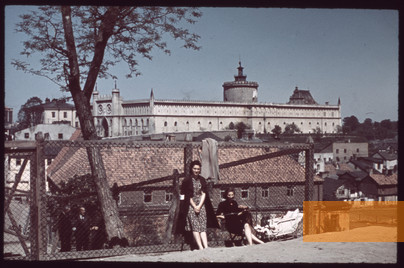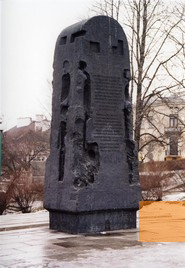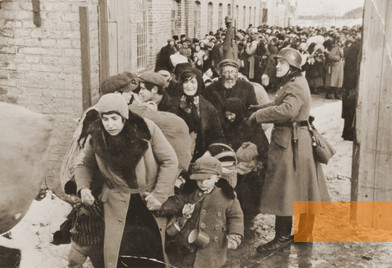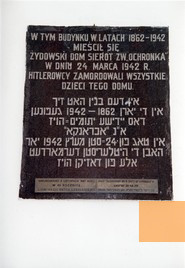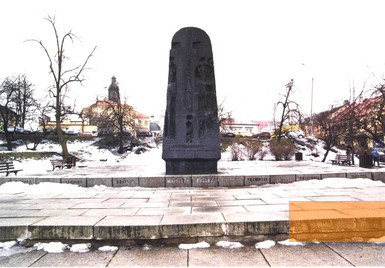A monument in the eastern Polish city of Lublin commemorates the city's Jews who, under German occupation, were forcibly moved by the SS to a ghetto and murdered at death camps from 1942 on.
The city of Lublin, located in eastern Poland, is one of the oldest cities in the country. The first settlement was established at this site in the early Middle Ages, with Jewish residents settling here from the 15th century on. Lublin soon became a cultural and economic centre. Following a fire in the 16th century, the city was rebuilt in Renaissance style. At the time, Lublin was established as a centre of Jewish culture – the city was home to a renowned yeshiva, a school for the study of the Talmud. In the course of the 19th and early 20th centuries, many Jewish unions, organisations and political parties were founded in Lublin, which was part of Russia before Poland gained its independence in 1918.
Prior to the German invasion of Poland in 1939, Lublin had about 122,000 residents, of whom 40,000 were Jews. The Jewish community of Lublin was one of the largest in pre-war Poland. Under German occupation, the Jews of Lublin were deployed as forced labourers and terrorised by the occupying regime. The SS leadership decided to establish a camp in the district of Lublin, which all Jews from the Generalgouvernement (German-occupied Poland) and the German Reich would be deported to. In 1941, the Germans abandoned this plan, by which time thousands had been deported to Lublin. In March 1941, about 34,000 Lublin Jews had to move into a ghetto. The SS and police leader in charge of coordinating »Aktion Reinhardt«, the campaign with the aim of murdering all Jews from the Generalgouvernement in extermination camps, had his headquarters in Lublin. In the spring of 1942, the SS dissolved the Lublin ghetto and murdered its former inmates at the Bełżec death camp. The few Jews who had remained in Lublin were murdered at the Majdanek concentration camp, a camp in the suburbs of Lublin, in the autumn of 1942.
Prior to the German invasion of Poland in 1939, Lublin had about 122,000 residents, of whom 40,000 were Jews. The Jewish community of Lublin was one of the largest in pre-war Poland. Under German occupation, the Jews of Lublin were deployed as forced labourers and terrorised by the occupying regime. The SS leadership decided to establish a camp in the district of Lublin, which all Jews from the Generalgouvernement (German-occupied Poland) and the German Reich would be deported to. In 1941, the Germans abandoned this plan, by which time thousands had been deported to Lublin. In March 1941, about 34,000 Lublin Jews had to move into a ghetto. The SS and police leader in charge of coordinating »Aktion Reinhardt«, the campaign with the aim of murdering all Jews from the Generalgouvernement in extermination camps, had his headquarters in Lublin. In the spring of 1942, the SS dissolved the Lublin ghetto and murdered its former inmates at the Bełżec death camp. The few Jews who had remained in Lublin were murdered at the Majdanek concentration camp, a camp in the suburbs of Lublin, in the autumn of 1942.
At least 34,000 Jews from Lublin were murdered in the extermination camps during »Aktion Reinhardt«. Only a few hundred Jews from Lublin survived.
A handful of Jewish survivors returned to Lublin after the war. They established a Jewish community, which existed until the 1970s; the community later disintegrated. Today, only a few Jews remain in the city.
In 1963, on the 20th anniversary of its liquidation, the Jewish community erected a monument to the victims of the ghetto. It is in the form of a Jewish tombstone and made of black granite. Inscribed at the foot of the monument are the sites at which the Jews from the Lublin region were murdered. The dedication reads: »In eternal memory of the Polish citizens of Jewish nationality from the voivodeship Lublin who were beastly murdered by the Hitlerite Fascists during the Second World War«. There is a further inscription in Polish and in Yiddish, a quote from the »The Song of the Murdered Jewish People« by poet Itzhak Katzenelson (1886-1944): »I am searching for my dead [...] In every hill of ash« (translation by Judie Ostroff-Goldstein).
The monument was originally located on »Plac Ofiar Getta« (English: »Ghetto Victims' Square«). In 2006 the monument was moved to another location in central Lublin due to planned construction works. The relocation remains controversial.
In 1963, on the 20th anniversary of its liquidation, the Jewish community erected a monument to the victims of the ghetto. It is in the form of a Jewish tombstone and made of black granite. Inscribed at the foot of the monument are the sites at which the Jews from the Lublin region were murdered. The dedication reads: »In eternal memory of the Polish citizens of Jewish nationality from the voivodeship Lublin who were beastly murdered by the Hitlerite Fascists during the Second World War«. There is a further inscription in Polish and in Yiddish, a quote from the »The Song of the Murdered Jewish People« by poet Itzhak Katzenelson (1886-1944): »I am searching for my dead [...] In every hill of ash« (translation by Judie Ostroff-Goldstein).
The monument was originally located on »Plac Ofiar Getta« (English: »Ghetto Victims' Square«). In 2006 the monument was moved to another location in central Lublin due to planned construction works. The relocation remains controversial.
- Name
- Pomnik Eksterminacji Ludności Żydowskiej
- Address
-
ul. Radziłłowska / ul. Niecała
20-109 Lublin - Web
- http://teatrnn.pl/leksykon/artykuly/pomniki-lubelskie-pomnik-eksterminacji-ludnosci-zydowskiej-ofiar-getta/
- teatrnn@tnn.lublin.pl
- Open
- The monument and the memorial plaques are always accessible.


